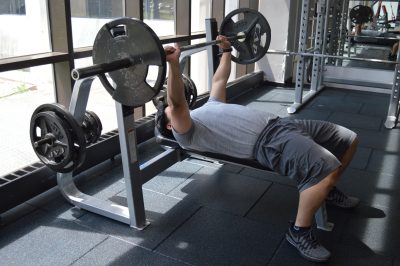The bench press has been a staple of every program since the early days of weight lifting. Every school and coach uses this exercise as a method of assessing upper body strength and power. We broke it into two phases, concentric and eccentric.
Muscle Emphasis
The primary muscle used to create the movement for the bench press are Pectoralis Major, all Triceps and Anterior Deltoid. The secondary muscle used are Pectoralis Minor, Latissimis Dorsi, Coraco Brachialis and Serratus Anterior.
Starting Position of a Barbell Bench Press
Lying on a flat bench with your feet on the floor grip the barbell with hands slightly wider than shoulder width apart. You want your elbows to be slightly less than 90 degrees relative to the body. Keep elbows closer to the trunk rather than flared out. It is recommended that a spotter take the weight off the rack for you.
Bench Press Movement
Eccentric: Lower the bar down towards the chest to about one inch before touching the chest. Do this in a controlled 2-3 second tempo.
Phase 2 Concentric: Push the bar back to the starting position in an explosive fashion. Do not completely lock the elbow, just extend it so it is almost locked.
Tips for proper form
- Keep a neutral spine; brace abdominals, glutes, and lower body.
- Keep the elbows just below 90 degrees and make sure the wrist and elbows line up.
- Push through the palms of the hand.
- Keep the feet planted on the floor.
Common Mistakes
- Shrugging the shoulders.
- Raising the hips off of the bench and arching the spine. Hips should remain on the bench.
- Too wide a grip will put stress on the shoulder. Do not take a grip much wider than shoulder width.
- Bring the bar to roughly where your sternum is. Below the sternum is too low and going near the collar bone is too high.
- Do not let your ego dictate the weight you use because your form will suffer.
The bench press has value when applied correctly. It is important for a heavy bencher to work on shoulder mobility and strengthening the rotator cuff muscles. Insufficient strength can lead to shoulder impingement and AC joint injuries. Clients with any shoulder or neck issues should avoid the bench press.

_______________________________________
GUEST AUTHORED BY: Kevin Chen

Kevin Chen is a Certified Personal Trainer through NFPT. He attended Tuckahoe High School where he was the captain of the 2010 State Championship Football Team. After graduating, he went on to attend the University of Hartford where he received his Bachelor of Science degree in Health Science. Kevin spent his summers during college as a volunteer offensive and defensive line coach with the Tuckahoe High School football team. He has attended multiple collegiate football camps and seminars learning from collegiate coaches and trainers from across the country including: Princeton, Lafayette, Stony Brook, Delaware, and Utica.
Kevin’s main focus is to implement strength and resistance training in addition to mobility exercises to improve athletic performance and overall health. Kevin stresses training and strengthening joints at the end range of motion in order to improve power, speed, and mobility. He is also currently training to improve his Olympic lifts as well as researching different techniques used by different Olympic coaches and athletes that will have the best carryover to athletic performance.
Guest authors offer experience and educational insights based on their specific area of expertise. These authors are contributing writers for the NFPT blog because they have valuable information to share with NFPT-CPTs and the fitness community at-large. If you are interested in contributing to the NFPT blog as a guest, please send us a note expressing your interest and tell us how you can contribute valuable insights to our readers. We look forward to hearing from you! Send to editor@nfpt.com

